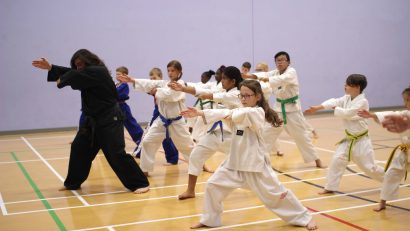All the syllabus for current red belt students to learn in order to gain their red + black stripe belt (1st kup).

Jump to: Patterns | Sparring | Theory
Linework
Front snap kick walking stance double punch.
Walking stance low block rising block.
Side kick reverse side kick land L stance guarding block.
First three moves Won-Hyo pattern
Bending ready stance, side kick, walking stance front elbow strike.
Walking stance hooking block, hooking block punch.
Kicking consecutively with the back leg: double turning kick land L stance forearm guarding block.
L stance knife hand guarding block slip the front foot to walking stance upper elbow strike.
Kicking consecutively with the back leg: double side kick land L stance forearm guarding block.
Walking stance pressing block.
Kicking consecutively with the back leg, hooking kick side kick land L stance forearm guarding block.
First two moves of pattern Toi-Gye.
Turning kick reverse turning kick land L stance forearm guarding block.
L stance low knife hand guarding block slip the front foot to walking stance circular block.
Kicking consecutively with the back leg, turning kick axe kick land L stance forearm guarding block.
L stance obverse punch, slip the front foot to walking stance X fist pressing block.
Jumping kicks on the spot: Front snap kick, turning kick, reverse side kick and front leg side kick.
Patterns
Pattern Chon-Ji
Patterns Dan-Gun or Do-San
Patterns Won-Hyo or Yul Gok
Patterns Joong Gun and Toi Gye
Pattern – Hwa-Rang:
Hwa-Rang
Hwa-Rang means ‘Flowering Youth’ and is named after the Hwa-Rang youth group, which originated in the Silla Dynasty around 600 AD. This group eventually became the actual driving force for the unification of the three Kingdoms of Korea. The 29 movements refer to the 29th Infantry Division, where Tae Kwon-Do developed into Maturity.
Movements in pattern: 29
Starting position: Closed Ready Stance C

The diagram for this pattern assumes that the student is stood on line AB and is facing D.
- Move the left foot to B to form a sitting stance, executing a left middle pushing block.
- Execute a right middle punch maintaining a sitting stance.
- Execute a left middle punch maintaining a sitting stance.
- Pull the left foot back, form a left L-stance towards A, executing a twin forearm block.
- Execute a left upward punch pulling the right side fist in front of the left shoulder, maintaining a left L-stance.
- Execute a right middle side punch to A forming a right fixed stance in a sliding motion.
- Pull the right foot back, form a left vertical stance, executing a right downward knife hand strike.
- Move the left foot to A forming a left walking stance, executing a left middle punch.
- Move the left foot to D forming a left walking stance, executing a left low outer forearm block.
- Move the right foot to D forming a right walking stance, executing a right middle punch.
- Pull the left foot toward the right foot while bringing the left palm to the right fore fist.
- Execute a right middle side piercing kick pulling both hands in the opposite direction, then lower to form a left L-stance, executing a right middle outward knife hand strike.
- Move the left foot to D forming a left walking stance, executing a left middle punch.
- Move the right foot to D forming a right walking stance, executing a right middle punch.
- Move the left foot to E turning counter clockwise to form a right L-stance, executing a middle knife hand guarding block.
- Move the right foot to E forming a right walking stance, executing a right middle straight finger tip thrust.
- Move the right foot on line EF forming a right L-stance toward F, executing a middle knife hand guarding block.
- Execute a right high turning kick to DF then lower it to F.
- Execute a left high turning kick to CF then lower it to F forming a right L-stance, executing a middle knife hand guarding block. Perform 18 and 19 in a fast motion.
- Move the left foot to C forming a left walking stance, executing a left low outer forearm block.
- Execute a right middle punch forming a right L-stance toward C, pulling the left foot.
- Move the right foot to C forming a left L-stance, executing a left middle punch.
- Move the left foot to C forming a right L-stance toward C while executing a middle punch to C with the right fist.
- Execute an X-fist pressing block forming a left walking stance toward C, slipping the left foot.
- Move the right foot to C in a sliding motion forming a right L-stance toward D while thrusting with the right side elbow.
- Bring the left foot to the right foot, turning counter clockwise to form a closed stance toward B, executing a right middle inner forearm block and a left low outer forearm block.
- Execute a left middle inner forearm block and a right low outer forearm block maintaining a closed stance toward B.
- Move the left foot to B forming a right L-stance, executing a middle knife hand guarding block.
- Bring the left foot to the right foot and then move the right foot to A forming a left L-stance, executing a middle knife hand guarding block.
Bring the right foot back to the ready position.
Sparring
1 step sparring (Advanced, no locks, restraints or take-downs)
Red belts are expected to develop their own techniques for one step sparring using the following optional guidelines. These are not in any set order!
- Hand only
- Foot only
- Hand and foot
- Foot and hand
- Jumping
- Knee and elbow
Self Defence
Free sparring
Two against one free sparring
Theory
At this grade you can be tested on ALL theory up to and including second kup. Children who up until this grade have been able to answer easier questions from the children’s questions sheet, are now expected to know the full adult syllabus – I recommend revising the full theory of all previous grades.
What are the tenets of TaeKwon-Do?
What is the meaning of Pattern Hwa-Rang and how many moves does it have.
What is the meaning of Red Belt?
What is the meaning of Black Belt?
Identify or demonstrate all new techniques introduced at this grade, including identifying their blocking or attacking tools.
Identify or demonstrate any technique or stance learnt to date, and identify or demonstrate the blocking or attacking tool.
What is the difference between a guarding block and an ordinary block?
What is a pressing technique?
What is a rising technique?
What is an inward technique?
What is an outward technique?
What makes a stance a left or right stance?
What is the weight distribution of any of the stances that you have learnt?
Explain obverse and reverse techniques.
What is the difference between a jumping and a flying technique?
Name all the high section target areas.
Name all the middle section target areas.
Name all the low section target areas.









